

 JOHN CHANDLER tells us about his favourite locomotive.
JOHN CHANDLER tells us about his favourite locomotive.
When I was asked to provide an article about My Favourite Class, my initial reaction was towards my beloved SBB and their Class 460 Re4/4 locomotive, referred to by most of my friends as a slab. However, I had a rethink and realised that there is a locomotive with which I have had much longer familiarity, has even more following and is even more iconic.
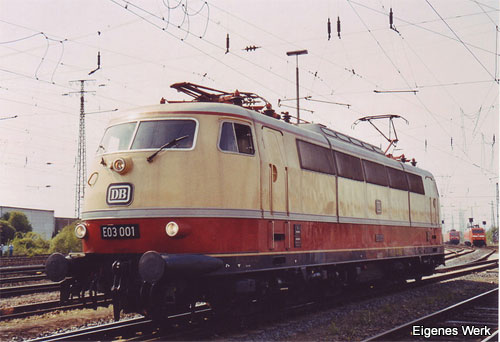
I present the German Class 103.
My first encounter with the E03 (as it was first known) was when my late father brought back, from a business trip to Germany in 1971, an Arnold N scale model of this locomotive and a rake of 5 coaches, all in TEE (Trans Europ Express) livery. The aesthetic shape of the locomotive (and, reading the Arnold catalogue, its hauling capabilities) appealed to me and I fell in love! I still have the model in my collection, but after 45 years, it is looking a bit the worse for wear and over attention!
Quoting from Platform 5's German Railways, Part 1, the class 103, as it now known, was the DB flagship locomotive of the latter part of the 20th Century. The wheel arrangement is Co-Co, i.e. three axles per bogie, all powered (I much prefer the Swiss designation which, in this case, is 6/6!) (If it had been A1A-A1A the Swiss equivalent would simply be 4/6).
The locomotives were built between 1969 and 1974 by a collaboration of Henschel, Krauss-Maffei and Krupp with electrics from Siemens, AEG-Telefunken and Brown-Boveri.
For the record, their specification reads:
Four prototypes were built in 1965. They were first shown in public at the 1965 Internationale Verkehrsausstellung (International Transport Fair) in Münich, and were first designated Class E03 and then Class 103.0 after the introduction of the new numbering system. To gain experience the Class E03 was run on exhibition runs to Augsburg, where they regularly reached speeds of 200kph. As a result of these runs it was found that the 5,950 kW or 7,980 hp (continuous — 6,420 kW or 8,610 hp one hour) was insufficient. For serial production stronger motors and reinforced transformers were added when the locomotive entered production.
The first Class 103.1 entered service in May 1970. DB wanted the locomotive to be capable of pulling a 400 tonne train at 200kph (120mph) for their new Intercity system. This was to begin running fast services between major cities in 1971 - with the 103.1 fast becoming the backbone of TEE and InterCity services in Germany.
To provide more space in the driver's cab, from 103 216 the body was extended by 700mm.
The Class 103 entered its twilight years in the early nineties, becoming worse for wear due to the fact that were practically the only class of locomotive being used for high speed trains, and also down to DB maintenance cutbacks. The new InterCityExpress (ICE) trains entered service in 1991 on high speed routes. The Class 103 was directly replaced by the Class 101 in 1996. Its use was reduced year on year (apart from in 1998 when all ICE trains were taken out of service following the Eschede train disaster) until when it was retired from regular service in 2003. However, in 2013 preserved Class 103 locomotives returned to service running trains from Münich, and have re-entered service in other parts of Germany as well. Two Class 103s are still used by DB for test runs.
The Class 103 is often produced by the following manufacturers:

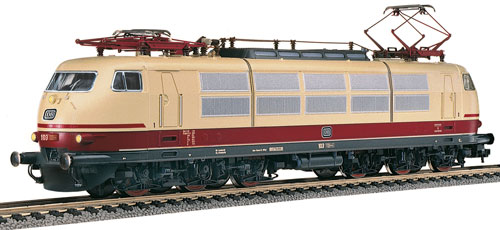
CLICK HERE for the Fleischmann model range.

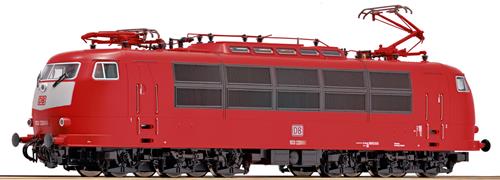
CLICK HERE for the Roco model range.

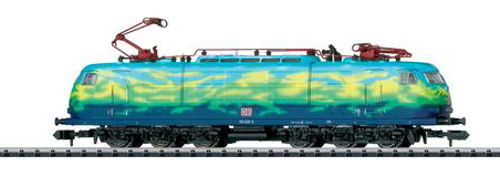
CLICK HERE for the Minitrix model range.
CLICK HERE for the Trix model range.


CLICK HERE for the Märklin model range.

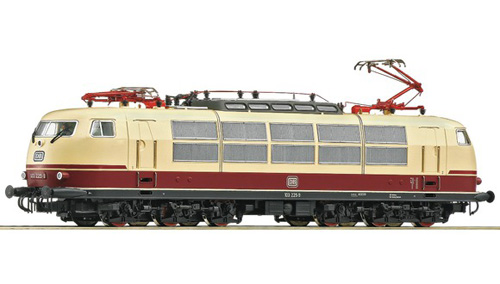
CLICK HERE for the PIKO model range.